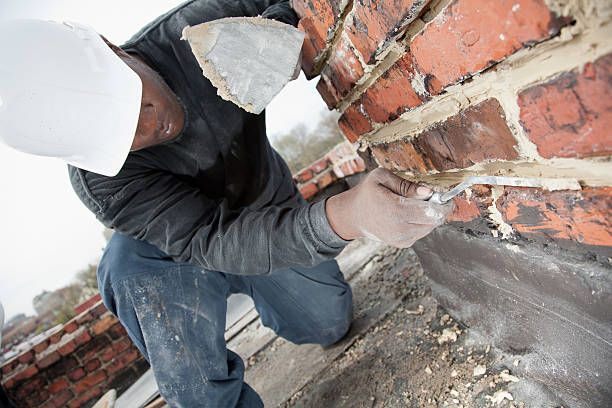Trusted Tuckpointing Services for Mending Block and Stone Surfaces
Trusted Tuckpointing Services for Mending Block and Stone Surfaces
Blog Article
Opening the Keys of Sustainable Stonework Building Practices for Eco-Friendly Buildings
In the world of contemporary building and construction, the search of sustainable techniques has become paramount. Among the myriad techniques to environmentally friendly structure, sustainable stonework building attracts attention as a tried and true and resilient method that holds a wealth of untapped possibility. From the option of materials to cutting-edge building techniques, the keys to attaining sustainability within stonework building and construction are complex and interesting. By discovering the benefits, materials, techniques, and future fads of sustainable masonry, a much deeper understanding of how these techniques can shape the future of eco-friendly buildings arises.
Benefits of Sustainable Stonework Building
Embracing lasting masonry building and construction methods not only reduces environmental influence yet likewise offers lasting financial benefits to building contractors and areas. By using materials like recycled blocks, obstructs, and stones, building contractors can substantially decrease the carbon impact of their jobs while promoting source performance. Furthermore, lasting masonry building methods, such as appropriate insulation and thermal mass properties, can improve power performance within buildings, causing minimized functional prices over time.
Additionally, the resilience and durability of stonework frameworks add to long-lasting economic advantages. Buildings constructed using lasting stonework techniques commonly require less maintenance and repair service, translating to cost savings for builders and property owners. The long life of stonework materials also makes certain that structures remain stable and protected, lowering the need for regular restorations or replacements.
Eco-Friendly Masonry Products
Making use of environmentally friendly masonry materials is an essential action in the direction of improving the sustainability of building and construction techniques and reducing ecological influence while taking full advantage of lasting economic advantages. Sustainable masonry materials are sourced, generated, and made use of in a way that minimizes general environmental influence. Materials such as recycled bricks, recovered rock, and lasting concrete blocks are becoming increasingly preferred choices for eco-conscious contractors. Recycled bricks, for instance, not only divert waste from land fills but also call for much less energy to generate compared to brand-new blocks. Reclaimed rock offers a distinct visual appeal while lowering the requirement for brand-new quarrying. Lasting concrete obstructs integrate recycled aggregates and may include better insulation residential properties, adding to power performance in buildings.
Moreover, natural products like adobe, rammed earth, and straw bales give exceptional thermal mass residential or commercial properties, reducing the demand for home heating and cooling power. These materials are typically in your area available, advertising local economic climates and lowering transportation-related carbon emissions. By selecting environment-friendly stonework materials, building and construction jobs can substantially reduce their ecological footprint and add to the creation of much healthier, more lasting constructed atmospheres.
Energy-Efficient Stonework Strategies
Energy effectiveness plays a crucial function in enhancing the sustainability of stonework building techniques. By executing energy-efficient masonry methods, building contractors can dramatically minimize the overall energy usage of a building, bring about reduced operational prices and a smaller sized environmental impact. One vital energy-efficient masonry technique is making use of thermal mass, which involves including thick materials like concrete or block into the building's framework to absorb and store heat. This assists regulate indoor temperatures, reducing the requirement for mechanical heating and cooling systems.

Advancements in Sustainable Masonry
Current improvements in sustainable masonry techniques have actually produced cutting-edge methods that are improving the construction market. One such advancement is the advancement of self-healing concrete, which utilizes microorganisms see here now installed within the concrete to recover splits autonomously. This advancement not just minimizes maintenance prices yet additionally improves the resilience of stonework frameworks, contributing to their sustainability.
One more remarkable advancement is using recycled accumulations in stonework building - masonry contractor. By incorporating products such as smashed ceramic waste or recycled glass into concrete blends, builders can decrease the ecological impact of building and construction projects while keeping architectural integrity. This practice not only diverts waste from landfills but additionally saves natural deposits, making it a vital innovation in sustainable stonework construction
In addition, the assimilation of electronic style tools, such as Building Info Modeling (BIM), is revolutionizing the way stonework structures are intended and created. BIM enables even more exact computations, decreased product wastefulness, and boosted power efficiency, ultimately resulting in even more sustainable building methods. These advancements jointly symbolize an appealing future for sustainable stonework building and construction in the era of environmentally friendly buildings.
Future Trends in Masonry Sustainability
With the innovative strides made in lasting stonework techniques, the future patterns in masonry sustainability are positioned to additional websites revolutionize the construction market. One of the essential fads forming the future of masonry sustainability is the increased combination of innovation. Innovations such as Structure Information Modeling (BIM) and virtual reality simulations are being made use of to maximize stonework construction procedures, leading to reduced product waste and enhanced power performance in buildings.
In addition, the development of novel lasting products is readied to play a considerable role in enhancing the eco-friendliness of stonework building. masonry contractor. Innovations like self-healing concrete, recycled accumulations, and bio-based binders are getting grip for their ability to decrease ecological influence while preserving architectural stability

Verdict
In verdict, lasting stonework construction practices offer various advantages for environmentally friendly buildings. masonry contractor. Developments in sustainable masonry are continuously being created to additionally enhance the environmental efficiency of buildings.
Report this page